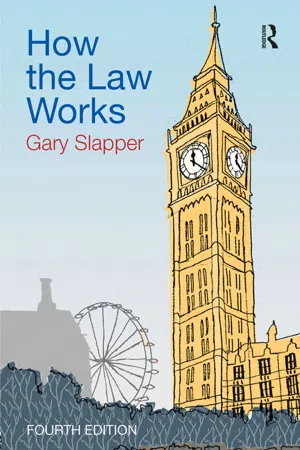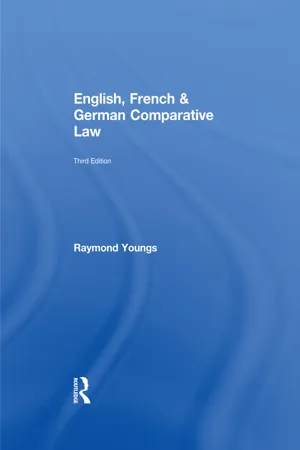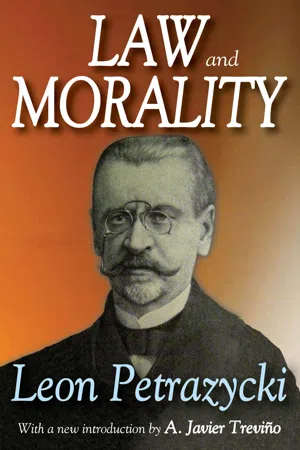Law
Types of Law
Types of law refer to the various categories of legal principles and regulations that govern different aspects of society. Common types include criminal law, which deals with offenses against the state or public, and civil law, which addresses disputes between individuals or organizations. Other types include administrative law, constitutional law, and international law, each focusing on specific areas of governance and regulation.
Written by Perlego with AI-assistance
8 Key excerpts on "Types of Law"
Learn about this page
Index pages curate the most relevant extracts from our library of academic textbooks. They’ve been created using an in-house natural language model (NLM), each adding context and meaning to key research topics.
- eBook - ePub
English Legal System
An Emerald Guide
- (Author)
- 2015(Publication Date)
- Straightforward Publishing Digital(Publisher)
1
The Framework of Law
Law covers a wide variety of areas. There are different categories of law: national law; international law which is divided into public and private law and further sub-categories discussed later.International law
International law concerns itself with inter-nation disputes and conflict. This law, in the main, derives from various treaties which have been agreed over time between different governments.National law
This is the law which applies within each individual nation. Within national law there is a distinction between public and private law. Public law involves the government or state in some way and private law is concerned with disputes and conflict between individuals and businesses. Public and private law, as mentioned can be further sub-divided.Public law
There are three distinct areas of public law:1. Constitutional law
Constitutional law controls and sets out the framework for government, and methods of government.2. Administrative law
This controls how the ministers of government, both national and local, can operate. A key part of administrative law is that of the right to judicial review of decisions made by government.3. Criminal law
Criminal law deals with the types of behaviour, whether individual or on a business level, which are considered outside the boundaries of the general law and accepted moral codes and which are punishable. A person who commits a crime is said to have offended against the State and the State has the right to prosecute them and punish them if found guilty.Private law
Private law is usually termed civil law and there are many differing branches. The main ones dealing with everyday matters are family law, contract law, tort (negligence) company law and employment law. Civil law is very different in nature from criminal law. Whereas criminal law deals with crimes against the state private or civil law deals with disputes between individuals - eBook - ePub
- Ryan Murphy, Frances Burton(Authors)
- 2020(Publication Date)
- Routledge(Publisher)
A further division in the classification of law comes in the form of the differences between civil and criminal law. When we talk of civil law in this way, we mean the branch of law that governs the relationship between individuals (particularly where that relationship breaks down), as opposed to criminal law which seeks to redress wrongs done by individuals against the state. The civil law therefore encompasses private law disputes (such as breach of contract, negligence and matrimonial disagreements etc.) whereas the criminal law deals with offences of varying seriousness (such as murder, theft, speeding etc.).Civil and criminal law are both subject to their own sets of procedures and have their own language for describing similar aspects of cases. There are more important differences such as the standard of proof required to be successful in a given case with the ‘balance of probabilities’ being used in civil cases and ‘beyond all reasonable doubt’ forming the criminal standard. Due to the significant differences in process, there are dedicated chapters on the civil (Chapter 10 ) and criminal justice (Chapter 11 ) systems later in this work.Public law and private law
In some ways this categorisation is a broader version of the distinction between criminal law and civil law. Public law concerns the relationship between the individual and the state and also between the different institutions of the state. In this way, criminal law is a form of public law as it concerns the way in which the state redresses offences against it. Other branches of public law include constitutional law (which is concerned with the creation of Government and the regulation of the powers of the state and the rights of individuals against the state) and administrative law (which is concerned with the activities of Government agencies such as those administering social security or other welfare payments). The cornerstone of public law is the concept of ‘judicial review’ whereby individuals can challenge the actions of the Government (or its agents) before a court.Private law, on the other hand, governs the relationship between individuals and is often used synonymously with the term ‘civil law’.Procedural or substantive law
This method of categorisation relies less on the type of source under discussion but rather on its purpose. Substantive law lays down the principles of a given area of law, for example the required elements of a criminal offence. Substantive law establishes the rights and obligations of an individual in a given situation. Procedural law will set out the rules and principles by which that substantive law is administered - eBook - ePub
- Gary Slapper, David Kelly(Authors)
- 2012(Publication Date)
- Routledge(Publisher)
Types of LawThere are many ways to divide law into different types. Putting law into categories is like putting people into categories – it can be done in different ways and for different purposes. If you take 100 random people in a crowd you could sort them into groups according to height, or weight, or age, or occupation, or skin colour, or blood type, or place of birth, or any number of other criteria. A 34-year-old, 5 ft 7 in., dark-haired female musician, weighing 8 stone, and born in Hong Kong with blood type O, would be placed among different subsets of people from the 100 depending on how people were being categorised.In the same way, law can be put into different groups according to different criteria. The quantity of law that applies in the UK today is very considerable. It is contained in thousands of voluminous law reports of decided cases judged over many centuries, statutes and regulations passed by Parliament, and a gigantic quantity of European law and European human rights law.Taking this law as a whole, it can be divided according to whether it has originated from judicial pronouncement (judge-made law) or legislation (from Parliament). Equally, it could be divided according to whether it is private law (law, like contract law, which applies to people in the private relations they might have as citizens or organisations) or public law (like criminal law which applies to everyone at large).Very commonly, a single transaction or relationship or event will entail the relevance of a great many laws and several Types of Law. For example, consider the awful case of a lorry travelling at speed along a motorway, crashing into a car that had stopped on the hard shoulder, killing one of a number of people standing near the car, and then smashing through the barrier and plunging down an embankment on to a railway line in front of an oncoming train. All sorts of law could be applied to such a dreadful situation including the following: - eBook - ePub
Law and Society
An Introduction
- Steven Barkan(Author)
- 2018(Publication Date)
- Routledge(Publisher)
- The civil law governs private transactions among individuals and organizations, including marriage and divorce, contracts, wills, and real estate transactions. A violation of a civil law is called a tort.
- Executive orders refer to laws passed and actions undertaken by the executive branch of the government. Several types of executive orders exist: (1) proclamations, (2) the establishment of task forces, (3) orders to create or reorganize executive branch departments and agencies, and (4) orders that change governmental policy or undertake governmental action to address an issue or problem.
- Administrative law refers to the rules and regulations of administrative and regulatory agencies. Regulatory agencies perform both an enforcement and judicial function. Administrative law is far more extensive and complex now than it was a century ago, thanks to industrialization and the development of the administrative-welfare state.
- Other distinctions in Types of Law include statutory vs. case law, public law vs. private law, and substantive law vs. procedural law. A related distinction is substantive justice vs. procedural justice.
- The U.S. military has its own legal system as outlined in the Uniform Code of Military Justice. Critics say that military law can be arbitrary and unfair because of the power given to military commanders and because military defendants lack some of the rights and protections their civilian counterparts enjoy.
- The hundreds of Native American tribes share an understanding of law that helps distinguish Native American law from the law practiced by the federal and state governments. In general, Native American law favors compromise solutions and reconciliation and restitution.
- International law governs the relationships among the nations of the world and among organizations with international dealings, but it has no enforcement power in terms of police. The International Court of Justice of the UN handles many kinds of international disputes but lacks effective enforcement powers. The important Geneva Conventions govern the conduct of war, the treatment of prisoners of war, and other wartime matters.
- eBook - ePub
- Gary Slapper(Author)
- 2016(Publication Date)
- Routledge(Publisher)
7Types of LawImagine a very large fruit basket filled with every type of fruit. If you were asked to divide its contents into different categories, there would be various ways in which you could approach that task. There would be no right way of doing this. It would all depend on what the person asking you to make the categorisations had as their criterion for division. You could divide all the fruit into groupings such as citrus and non-citrus, or tropical and non-tropical. Or you might divide the fruits according to colour, putting all those that are orange in one category, all those that are green in another, and so on. You could divide up the contents of the basket according to the shape of the fruit, or its country or continent of origin.So, if there was an orange in the basket it could be placed in one of several categories depending on how the division was made. Similarly, classifying law can be done in various ways. The quantity of law that applies in the UK today is very considerable. It is contained in thousands of voluminous tomes of law reports of decided cases judged over many centuries, statutes and regulations passed by Parliament, and a gigantic quantity of European law and European human rights law.Taking this law as a whole, it can be divided according to whether it has originated from judicial pronouncement (judge-made law) or legislation (from Parliament). Equally, it can be divided according to whether it is private law (law that applies to people in respect of the private relations they might have as citizens or organisations, for example contract law) or public law (law that applies to everyone at large, for example criminal law).Very commonly, a great many laws, and several Types of Law, will be relevant to a single transaction or relationship or event. For example, consider the awful case of a lorry travelling at speed along a motorway, crashing into a car that had stopped on the hard shoulder, killing one of a number of people standing near the car, and then smashing through the barrier and plunging down an embankment on to a railway line in front of an oncoming train. All sorts of laws could be applied to such a dreadful situation, including the following: - eBook - ePub
- Tom Craig, David Campbell(Authors)
- 2012(Publication Date)
- Routledge(Publisher)
serve the citizens of a state, it is reasonable to expect that legal rules should vary according to differing national customs and societal expectations. In traditional Islamic law for example, adultery is considered to be illegal (breaking a legal rule) as it is in contravention of the Qu’ran (Koran). In consequence, the act, if discovered, is (theoretically) punishable by the Islamic state. In contrast, the sensibilities of citizens in western nations like the UK renders adultery an act which may contravene most people’s social or ethical code, but is not considered to be punishable by the state. This is not to say that adultery may not lead to indirect legal action in the event that the offended spouse elected to seek a divorce.The Purpose of Law
Legal rules serve essentially the same purpose as other types of rules. It does not take a lot of imagination to conceive of the chaos that would arise if football was deprived of its rules and the same is true of society at large. Laws serve three broad purposes:- to permit individuals to engage in lawful activities without apprehension or molestation by others;
- to restrict unlawful or otherwise disturbing individuals and behaviour;
- to constrain individuals to comply with legally required activities, such as the payment of taxes.
The normal functioning of society rests upon the assumption that the majority of people agree to comply with the law, in the same way that the normal functioning of a football match relies upon each player complying with the rules. It follows that the majority must view the laws that affect them as reasonable and fair – a situation theoretically guaranteed by having a democratically elected legislature.Important Distinctions in Law
When we consider the general area of laws and legal rules, we must be aware of two important ways of dividing law. The first concerns the seriousness of offences and the second concerns the source of law (Figure 14.1 ).Figure 14.1 Sources and categories of law.Civil Law and Criminal Law
At their simplest, matters of civil law and criminal law can be distinguished according to the perceived seriousness of the offences. Civil and criminal law are two distinct areas of legal practice and are overseen by separate parts of the judiciary.In matters of civil law - eBook - ePub
- Raymond Youngs(Author)
- 2014(Publication Date)
- Routledge(Publisher)
Legal systemsBefore discussing the contents of a legal system, it is necessary to distinguish between what is law and what is not. This is an extremely difficult thing to do, but we can consider law as broadly being rules that emanate from an authoritative source and prescribe what human conduct ought to be, and which are enforced by a sanction of some kind. The requirements of an authoritative source and the existence of a sanction distinguish law from mere custom and mere morality, but, as we shall see, it is difficult to disentangle both of these things from law.1Law is general in its application and abstract in its expression. It should also have some degree of permanence. There are some provisions that have the form, but not the substance, of law, for example a piece of legislation that enables a particular development scheme to proceed or one that relieves a limited number of defined individuals of their legal obligations.The English legal system tends to be practical and pragmatic. It grew originally from case law, although many areas of it are now based on statute law. It is not regarded as a complete system, but rather as one that is in a continual process of growth. Roman law and academics have had little influence, although legal authors (and in particular the great textbook writers of the nineteenth century) have helped to turn the legal materials into a system.The French and German legal systems, on the other hand, are considered to be complete and coherent. They tend to be conceptual, and have been heavily influenced by Roman law and academic theory. The significant parts of the systems are expressed by the legislature in codes. - eBook - ePub
- Leon Petrazycki, A. Javier Trevino(Authors)
- 2017(Publication Date)
- Routledge(Publisher)
Not only, then, do the traditional groups termed “private law” and “public law” fall far short of embracing all the species of law (being adapted only to a definite stage of the development of law) — they so arrange the law that heterogeneous phenomena are combined into one group while homogeneous phenomena are separated from each other. The chief faults of this sort are that inter-state law is referred to public law together with the law of state organization, while the law of family organization (and wardship) is referred to private law. These branches of law should change places.Nomenclature not being a matter of prime importance, the terms “private” and “public” law may either be transferred to the two classes of law established supra as a higher division of law according to the content of the object ideas (social-ancillary or centralized law, and individual — free or decentralized law) or be reserved especially for the law with which contemporary jurisprudence is concerned after necessary regrouping has been duly effected.The scientific basis and justification of the proposed division of law into social-ancillary law and free law is that it provides a foundation whereon to construct adequate theories for the successful cognition and explanation of phenomena.Contemporary jurisprudence contains something like embryos of the two theories (of civil law and of public law) in the form of certain general assertions as to these alleged classes. Certain propositions are relevant in this connection.(a) It has already been shown that the independence of subjects is found in civil law whereas there are authority and subordination in public law. Leaving on one side the phenomenon of slavery and of the private law authority of the master in general, this characterization is admissible but only upon the essential condition precedent that the branches of law just mentioned be first transposed, since this characterization of private law is particularly well suited to international law and not at all appropriate to the law of family organization (an indication of faulty classification). With the faults of “jumping” thus eliminated, it is proper thereafter to extend the relevant characterizations to the two broad classes of law proposed above in order to eliminate the faults of “limping,” for the phenomenon of authority is bound up with the nature of social organizations in general and not with the state organization in particular.







